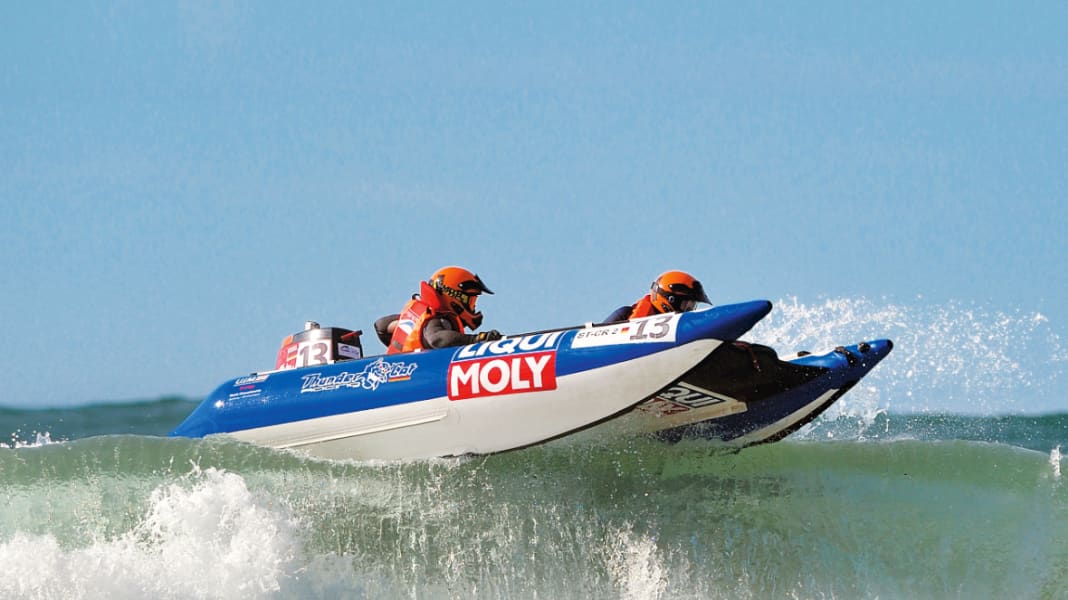
Flight angle 70 degrees, the propeller spinning through the air - that's not normal for a motorboat, is it? No, a normal recreational skipper would say. "Yes, it is," says Carsten Röhrig from Hamm, "especially in the 'surf' discipline." Röhrig should know, as he took part in the 2013 World Championships for inflatable boats in Cornwall, UK. And that's where things often get really rough in the true sense of the word. The special inflatable boats are built like a catamaran, have no fixed hull and can be folded to a maximum of a third of their length. They are powered by an outboard motor up to 750 cc and steered by the pilot using the tiller. The co-pilot - like the passenger in a motorbike sidecar - has to optimise the driving style in the wavy water by shifting their weight. Such a world championship lasts a whole week, with several races in a total of three disciplines.
Longhaul discipline
In the endurance race, competitors had to travel about 25 kilometres from the base camp in Pentewan eastwards across the sea towards Plymouth, then 2.5 kilometres towards the coast to find the turning point at the mouth of the River Looe and back to Pentewan. But the race didn't end there, the co-driver had to run along the beach to a turning mark and after returning to the boat, a second lap was scheduled on the sea, which on race day offered waves of up to three feet high. After two hours, the boats had covered around 110 kilometres and crossed the finish line.
Surf discipline
The second discipline doesn't just sound like surfing, it is surfing! After a day's rest, the entire group travelled across the Cornish headland to the other side of the Atlantic. Here the waves were naturally higher and the spot is popular with surfers. On the M-shaped course, the teams had to pass through the up to five-foot-high surf four times on each of their nine laps.
And when you get to the turning buoy, you never know in advance where the peak of the surf wave is. The co-pilot in particular has to use his weight shift to decide whether to approach the waves "high", causing the boat to fly through the air like on a launching pad and possibly overturn, or whether to cross them "low" in order to be able to turn better towards the tack, with the risk of too much water getting into the boat and the engine being "blown out".
"The co-pilot definitely has the harder job," Röhrig is certain, "he has to move the most, falling from the highest to the lowest point and therefore taking the most knocks." Röhrig speaks from experience, as he used to drive as a pilot until he changed his partner.
A day of training was followed by two days with two races each, which were made more difficult by fog and rain. Theoretically, each race lasts nine laps, but as occasionally a boat overturns on the waves and the race is then stopped immediately, the teams have more laps in their bones at the end of the day.
Circuit discipline
For the third discipline, the team travelled back to the quieter southern side of the peninsula. After a rest day, the final four races were held here. The course for the circuit races is basically rectangular, but not only has an additional S-curve on one long side, but also two different lap lengths. Due to the rules, you not only have to go full throttle here, but also think and tactic.
The long course is always ridden on the starting lap, followed by a short lap. On the following laps, the long course must be driven twice and the short course five times, while the ninth and final lap is another short lap. But it is up to each team to decide when to drive the short or the long laps in the middle. The team in the lead after the start will certainly do the short laps first in order to have the open water in front of them for as long as possible.
Those at the back will ride the long laps earlier in order to catch up afterwards if possible. In any case, the field will be shaken up and the final order will only be determined on the last lap. Of course, in the heat of the moment, you have to make sure you drive the right number of laps on the right tracks.
The World Championship
In addition to the hosts, teams from Germany, Ireland, Norway, Sweden and Russia took part. However, the teams from South Africa, where this sport is particularly popular and where most of the world champions are based, travelled the furthest.
This year's title went to the South African team Barry and Drickie Marx, Barry of whom had already won a gold medal in 2010. The silver medal went to Markus Hinz from Stade and his co-pilot Marc Pertzsch from Lübeck, although their boat was damaged in the "Surf" discipline. The British team "Ahmad Tea" provided them with a replacement boat so that they could still compete in the circuit race.
The German drivers have joined forces to form the "German Inflatable Powerboat Association" (G.I.P.A.). They will be competing at the Stralsund Harbour Festival (7/8 June), the Waterfront Bremen Cup (21/22 June) and the race in Rendsburg (6/7 September). Further information at: www.thundercatracing.info

